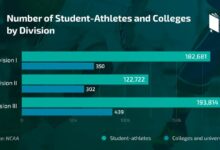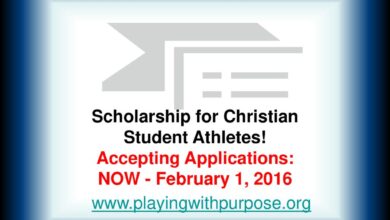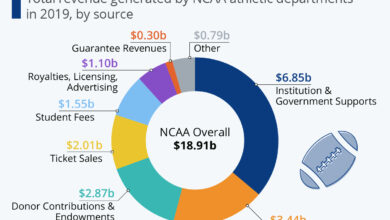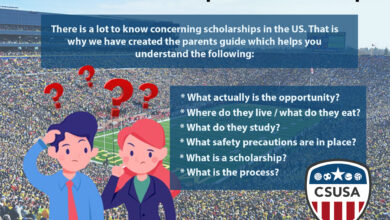Athletic Scholarship Eligibility Requirements: Meeting The Criteria For Success
Athletic scholarship eligibility requirements are crucial for student-athletes aiming to secure funding for their college education through sports. From academic standards to athletic achievements, these criteria play a vital role in shaping the future of aspiring athletes.
As we delve deeper into the world of athletic scholarships, understanding the key requirements and navigating the NCAA divisions becomes essential for those pursuing this path.
Athletic Scholarship Overview
Athletic scholarships are financial awards given to student-athletes by colleges and universities to help cover the cost of attending school while participating in sports. These scholarships are highly sought after and can provide opportunities for talented athletes to further their education while pursuing their athletic passions.
Sports Offering Athletic Scholarships
- Football
- Basketball
- Baseball
- Soccer
- Track and Field
Athletic scholarships are commonly offered in high-profile sports with competitive collegiate programs.
Benefits of Receiving an Athletic Scholarship
- Financial Support: Athletic scholarships can help cover tuition, room and board, and other expenses, making college more affordable for student-athletes.
- Opportunity to Compete at a High Level: Athletes can showcase their skills and compete against top talent in their sport at the collegiate level.
- Networking Opportunities: Student-athletes can build relationships with coaches, teammates, and alumni that can benefit them in their future careers.
Eligibility Criteria
To be eligible for an athletic scholarship, students must meet certain criteria that combine academic performance with athletic achievements. These requirements ensure that student-athletes can maintain a balance between their sports commitments and their academic responsibilities.
General Requirements
In general, student-athletes must have a strong academic record to be considered for an athletic scholarship. This includes maintaining a minimum GPA, meeting standardized test score requirements, and completing the necessary high school coursework. Additionally, students must demonstrate good character and leadership qualities both on and off the field.
Academic Standards
Student-athletes need to meet specific academic standards to qualify for an athletic scholarship. This typically involves maintaining a certain GPA throughout high school and college, as well as meeting eligibility requirements set by the NCAA or other governing bodies. Academic performance is a crucial factor in determining scholarship eligibility, as student-athletes must prove they can succeed in the classroom.
Athletic Achievements
In addition to academic performance, student-athletes must also demonstrate specific athletic achievements or skills to be considered for an athletic scholarship. This could include a strong performance in their respective sport, participation in competitive leagues or tournaments, and recommendations from coaches or scouts. Student-athletes must showcase their talent and potential to excel at the collegiate level to stand out to scholarship committees.
NCAA Division Requirements
To participate in collegiate sports and be eligible for athletic scholarships, student-athletes must meet the eligibility requirements set by the NCAA for Division I, II, and III schools. These requirements vary depending on the division and are crucial for student-athletes to understand before pursuing their athletic careers at the collegiate level.
Division I Eligibility Criteria
Division I schools have the most stringent eligibility requirements among the NCAA divisions. Student-athletes must meet academic standards by completing a certain number of core courses, achieving a minimum GPA, and obtaining a qualifying score on either the ACT or SAT exams. Additionally, athletes must be amateur and abide by NCAA rules regarding recruiting and eligibility.
Division II Eligibility Criteria
Division II schools also have academic eligibility requirements, but they are slightly less stringent compared to Division I. Student-athletes must complete a different set of core courses, maintain a minimum GPA, and achieve a qualifying score on standardized tests. Similar to Division I, athletes must maintain amateur status and follow NCAA regulations.
Division III Eligibility Criteria
Division III schools have the most flexible eligibility requirements, focusing more on the overall student-athlete experience rather than athletic prowess. There are no specific academic requirements set by the NCAA for Division III, but student-athletes must still meet the academic standards of the institution they are attending.
Division III athletes do not receive athletic scholarships based on their athletic abilities, but they may be eligible for other forms of financial aid.
Key Differences in Eligibility Requirements
| NCAA Division | Academic Requirements | Amateurism Rules |
|---|---|---|
| Division I | Specific core courses, minimum GPA, standardized test scores | Strict adherence to NCAA recruiting and eligibility rules |
| Division II | Different core courses, minimum GPA, standardized test scores | Similar to Division I but slightly less stringent |
| Division III | No specific NCAA requirements | Focus on overall student-athlete experience |
Maintaining Eligibility Between Divisions
Student-athletes who wish to transfer between NCAA divisions must ensure they meet the eligibility requirements of the new division. They may need to complete certain core courses, achieve a minimum GPA, and fulfill any other specific requirements set by the NCAA and the new division. It is essential for student-athletes to understand the differences in eligibility criteria between divisions to successfully transition while maintaining their eligibility status.
High School Performance
In determining athletic scholarship eligibility, high school performance plays a crucial role in showcasing a student-athlete’s academic and athletic abilities.
Factors Impacting Scholarship Eligibility
- GPA: A high GPA demonstrates academic excellence and dedication to studies, which is often a requirement for many athletic scholarships.
- Standardized Test Scores: SAT or ACT scores are also considered by scholarship committees to assess a student’s academic aptitude.
- Class Ranking: Being at the top of a class can enhance scholarship opportunities, showcasing a student’s commitment to academic success.
Role of Athletic Achievements
High school athletic achievements can significantly impact scholarship opportunities by demonstrating a student’s skills, dedication, and potential in their respective sport.
Academic vs. Athletic Performance
While athletic performance is essential, academic achievements are also highly valued in scholarship decisions. Many scholarships require a balance between academic excellence and athletic prowess.
Extracurricular Activities and Community Involvement
Participation in extracurricular activities and community service can enhance a student’s scholarship prospects by showcasing leadership, teamwork, and a well-rounded personality.
Recommendation Letters and Personal Essays
Recommendation letters from teachers or coaches can provide valuable insights into a student’s character, work ethic, and potential. Personal essays and interviews allow students to express their passion for their sport and academic goals.
Hypothetical Scenario
In a hypothetical scenario, a student with average grades but exceptional athletic skills may still secure a scholarship based on their talent and potential in their sport. This highlights the importance of showcasing both academic and athletic abilities in the scholarship application process.
Athletic Abilities and Skills
Athletic abilities and skills play a crucial role in the recruitment process for college sports teams. Coaches look for specific attributes in potential student-athletes to ensure they can contribute effectively to the team.
Specific Athletic Abilities and Skills
- Speed: A key attribute in many sports, speed allows athletes to outpace opponents and make quick plays.
- Strength: Essential for physical dominance and endurance during games or competitions.
- Agility: The ability to change direction quickly and maintain balance, crucial in sports that require sudden movements.
- Endurance: Vital for maintaining performance levels throughout a game or event, especially in sports with prolonged periods of activity.
Different Sports, Different Priorities
In basketball, height and coordination are often prioritized due to the nature of the game, while track and field focus more on speed and power. Each sport values specific abilities based on its requirements and gameplay style.
Showcasing Athletic Abilities
Student-athletes can demonstrate their skills during tryouts or recruitment events by actively participating, showcasing their strengths, and following coaches’ instructions. It is essential to exhibit a strong work ethic and a positive attitude.
Role of Athletic Achievements
Athletic achievements, such as awards or records, serve as tangible proof of proficiency in certain abilities and skills. They provide credibility to a student-athlete’s capabilities and can significantly impact their recruitment opportunities.
Coaches’ Recommendations
Coaches’ recommendations play a crucial role in the athletic scholarship selection process, providing valuable insights into the character, work ethic, and coachability of potential student-athletes.
Significance of Coaches’ Evaluations
Coaches’ evaluations carry significant weight in scholarship decisions, as they offer firsthand knowledge of an athlete’s performance, attitude, and potential for growth.
Criteria for Scholarship Recipients
- Consistent work ethic and dedication to improvement.
- Coachability and willingness to learn and adapt.
- Team player mentality and leadership skills.
- Strong communication and interpersonal skills.
Role of Coaches in Mentoring
Coaches not only evaluate athletic abilities but also mentor and develop student-athletes beyond the field or court, instilling values of discipline, teamwork, and resilience.
Impact of Recommendation Letters
A well-written coach’s recommendation letter can greatly enhance a student-athlete’s chances of receiving a scholarship, highlighting their strengths, character, and potential impact on a collegiate team.
Importance of Relationship Building
Building a strong relationship with coaches is vital in the scholarship application process, as it fosters trust, communication, and mutual understanding, leading to better support and advocacy for the student-athlete.
Recruiting Process
To begin the recruiting process for student-athletes seeking athletic scholarships, it is essential to understand the steps involved in getting noticed by college coaches and the importance of creating a recruiting profile or highlight video.
Getting Noticed by College Coaches
- Attend showcases, camps, and tournaments where college coaches will be present.
- Reach out to coaches via email, phone calls, or social media to express interest in their program.
- Ask your high school coach to contact college coaches on your behalf and provide recommendations.
- Maintain good academic standing as coaches look for well-rounded student-athletes.
Creating a Recruiting Profile or Highlight Video
- Include your academic and athletic achievements, statistics, and personal information in your recruiting profile.
- Create a highlight video showcasing your skills, abilities, and game footage to grab the attention of college coaches.
- Update your profile and video regularly to reflect any improvements or recent accomplishments.
- Share your profile and video with college coaches through email or recruiting platforms to increase visibility.
Compliance and Regulations
Maintaining scholarship eligibility as a student-athlete involves strict adherence to compliance rules set by the NCAA. Failure to follow these regulations can result in serious consequences that may jeopardize your scholarship status.
Common Violations and Consequences
- Common violations that can affect eligibility status include academic misconduct, substance abuse, and improper benefits.
- Consequences of not adhering to NCAA regulations may lead to suspension from games, loss of scholarship, or even permanent ineligibility.
Reporting Requirements and Approval for Gifts
- Student-athletes need to fulfill reporting requirements such as submitting academic progress reports and disclosing any gifts or benefits received.
- To seek approval for receiving gifts or benefits within NCAA regulations, student-athletes must consult with their athletic department compliance officer.
Suspected Violations and Reporting Process
- If a student-athlete suspects a violation by a coach or team member, they should report their concerns to the compliance officer or athletic director immediately.
- The compliance officer will then investigate the reported violation and take appropriate action based on NCAA regulations.
NCAA Division Compliance Rules
| NCAA Division | Compliance Rules |
|---|---|
| Division I | Stringent rules regarding recruiting, academic eligibility, and amateurism. |
| Division II | Less strict rules compared to Division I, but still require compliance with recruiting and eligibility regulations. |
| Division III | Focuses on the overall student-athlete experience with minimal restrictions on recruiting and financial aid. |
Case Study: Violation Repercussions
In a scenario where a student-athlete unknowingly violates a compliance rule, the repercussions can be severe. For example, if a student-athlete unknowingly accepts impermissible benefits, they may face suspension, loss of eligibility, and even damage to the team’s reputation. It is crucial for student-athletes to stay informed about NCAA regulations and seek guidance when in doubt.
Renewal and Continuation
Maintaining an athletic scholarship is not just a one-time achievement; it requires consistent effort and dedication from student-athletes. Here, we will delve into the requirements for renewing an athletic scholarship each year, factors that can jeopardize scholarship eligibility, and essential tips for student-athletes to sustain their scholarship status.
Renewal Requirements
To renew an athletic scholarship each year, student-athletes typically need to meet specific criteria set by the institution or athletic department. These requirements may include maintaining a certain GPA, remaining in good academic standing, participating in team activities, and upholding a positive image both on and off the field. Failure to meet these renewal requirements could result in the loss of scholarship funding for the upcoming academic year.
Loss of Scholarship Eligibility
Several factors can lead to the loss of scholarship eligibility for student-athletes. Academic struggles, disciplinary issues, injuries affecting performance, violations of team or NCAA rules, or not meeting the standards set by the coaching staff are common reasons for scholarship revocation. It is crucial for student-athletes to be aware of these potential pitfalls and take proactive steps to prevent them.
Tips for Maintaining Scholarship Status
– Prioritize academic success: Strive to excel in your studies and meet the GPA requirements for scholarship renewal.
– Communicate with coaches: Stay in regular contact with your coaches, seek feedback, and address any concerns promptly.
– Stay disciplined: Adhere to team rules, maintain a strong work ethic, and demonstrate commitment to your sport.
– Take care of your health: Stay in good physical condition, attend training sessions, and follow injury prevention protocols.
– Represent the team well: Uphold a positive reputation on and off the field, and act as a role model for your peers.
Financial Aid Considerations
When it comes to athletic scholarships, there are important financial aid considerations that student-athletes need to keep in mind. Understanding how athletic scholarships impact your overall financial aid package and the implications of accepting them is crucial for making informed decisions.
Impact on Financial Aid Package
Athletic scholarships can have a significant impact on a student-athlete’s financial aid package. While they can help cover tuition, room, board, and other expenses, it’s essential to note that they may affect the amount of need-based financial aid you can receive. This means that receiving an athletic scholarship could potentially reduce the amount of other forms of financial aid you are eligible for.
Difference from Other Forms of Financial Aid
It’s important to distinguish athletic scholarships from other forms of financial aid, such as academic scholarships, grants, and student loans. Unlike academic scholarships, athletic scholarships are awarded based on a student’s athletic abilities and skills rather than academic achievements. Grants are typically need-based, while student loans need to be repaid with interest.
Combining Athletic and Academic Scholarships
Student-athletes have the opportunity to combine athletic scholarships with academic scholarships or grants to maximize their financial aid opportunities. By leveraging both types of scholarships, student-athletes can cover a larger portion of their educational expenses.
Comparison Table
| Scholarship Type | Criteria | Financial Obligation |
|---|---|---|
| Athletic Scholarships | Awarded for athletic abilities | Do not need to be repaid |
| Academic Scholarships | Awarded for academic achievements | Do not need to be repaid |
| Grants | Need-based | Do not need to be repaid |
| Student Loans | Available for borrowing | Need to be repaid with interest |
Maximizing Financial Aid Opportunities
To maximize financial aid opportunities while maintaining eligibility for athletic scholarships, student-athletes should actively seek out academic scholarships, grants, and other forms of financial aid. It’s crucial to explore all available options to reduce the financial burden of attending college.
Implications on Future Financial Obligations
Accepting athletic scholarships can have implications on student-athletes’ future financial obligations post-graduation. While athletic scholarships cover educational expenses during college, student-athletes need to consider how they will manage any remaining financial obligations, such as student loans or other expenses, once they graduate.
Injury and Medical Conditions
In the world of student-athletes, injuries and medical conditions can have a significant impact not only on their physical abilities but also on their academic performance and mental well-being. It is crucial for student-athletes to understand how to navigate these challenges effectively.
Communicating Medical Conditions
When student-athletes are dealing with medical conditions or recovering from injuries, open communication with coaches and academic advisors is key. It is essential for student-athletes to clearly communicate their limitations, progress, and any necessary accommodations needed to support their academic and athletic performance effectively.
- Provide detailed updates on the status of injuries or medical conditions to coaches and academic advisors regularly.
- Discuss any modifications or adjustments needed in training, practices, or academic workload due to medical reasons.
- Seek guidance from medical professionals to ensure proper communication of medical conditions and recovery progress.
- Utilize resources provided by the institution for academic support and accommodations when necessary.
Balancing Recovery and Academic Responsibilities
Finding a balance between recovering from injuries and maintaining academic responsibilities can be challenging for student-athletes. It is essential to have a structured approach to ensure both physical and academic well-being are prioritized effectively.
- Create a detailed schedule that includes time for rehabilitation, academic work, and rest.
- Communicate with professors about any missed assignments or exams due to medical reasons.
- Utilize academic support services to stay on track with coursework during recovery periods.
- Prioritize self-care and mental health to manage the stress of balancing recovery and academic responsibilities.
Leave of Absence for Medical Reasons
In cases where student-athletes need to take a leave of absence due to medical reasons, it is crucial to follow the institution’s protocols and seek appropriate support to facilitate a smooth transition.
- Consult with academic advisors and coaches to understand the process of taking a leave of absence.
- Submit necessary documentation and medical records to support the request for leave.
- Stay in communication with the academic institution to ensure a seamless return to academic and athletic activities after recovery.
Role of Athletic Trainers and Medical Staff
Athletic trainers and medical staff play a vital role in supporting student-athletes through injuries and medical conditions. Their expertise and guidance are instrumental in ensuring a safe and effective recovery process.
- Receive regular treatment and rehabilitation guidance from athletic trainers to facilitate recovery.
- Follow medical advice and treatment plans provided by medical staff to promote healing and prevent further injuries.
- Engage in open communication with athletic trainers and medical staff to address any concerns or challenges during the recovery process.
- Work collaboratively with the medical team to establish a comprehensive plan for returning to full athletic participation safely.
Transfer Student Eligibility
When it comes to transfer students seeking athletic scholarships, there are specific eligibility requirements that need to be met in order to be considered for this financial assistance. These requirements may differ from those of incoming freshmen, so it’s essential for transfer students to be aware of these guidelines.
Academic Standing
Transfer students must ensure they meet the academic requirements set by the NCAA or other governing bodies to maintain eligibility for athletic scholarships. This includes having a minimum GPA and completing a certain number of academic credits to be considered for financial aid.
Athletic Performance
In addition to academic standing, transfer students must also demonstrate their athletic abilities and skills to coaches and recruiters. They may need to provide performance records from their previous school and participate in tryouts or showcases to showcase their talents.
Compliance with Regulations
Transfer students must comply with all regulations and guidelines set forth by the NCAA or other athletic organizations when it comes to transferring schools. Failure to follow these rules could result in loss of eligibility for athletic scholarships.
Impact on Scholarship Opportunities
Transferring schools can have an impact on scholarship opportunities for student-athletes. Depending on the reasons for transferring and the timing of the transfer, scholarship offers may vary. It’s important for transfer students to communicate with coaches and recruiters to understand how transferring schools can affect their financial aid.
International Student Eligibility
International students seeking athletic scholarships must meet specific eligibility criteria that differ from those of domestic students. These criteria encompass various aspects such as visa requirements, language proficiency, and academic equivalency considerations. Navigating these requirements can pose challenges for international student-athletes, impacting their eligibility process.
Visa Requirements
International student-athletes must secure the appropriate visa to study and compete in the United States. Typically, this involves obtaining an F-1 student visa, which permits enrollment in a full-time academic program. It is essential to adhere to all visa regulations to maintain legal status throughout the scholarship period.
Language Proficiency
Proficiency in the English language is crucial for international student-athletes to succeed academically and athletically. Many institutions require proof of English proficiency through standardized tests like TOEFL or IELTS. Demonstrating language skills ensures effective communication in the classroom, with coaches, and among teammates.
Academic Equivalency Considerations
International transcripts may need to be evaluated for academic equivalency to ensure they meet NCAA eligibility requirements. The evaluation process determines the comparability of foreign academic credentials to U.S. standards. It is essential to provide accurate and official documentation for a comprehensive assessment.
Challenges Faced by International Student-Athletes
International student-athletes encounter unique challenges during the eligibility process, including cultural adjustments, language barriers, and unfamiliar academic systems. Adapting to a new environment while balancing academic and athletic commitments requires resilience, determination, and support from coaches and academic advisors.
Title IX Compliance
Title IX regulations play a crucial role in ensuring gender equity in athletic scholarship distribution for male and female student-athletes. Schools must adhere to these regulations to provide fair and equal opportunities for both genders in sports programs.
Impact of Title IX Regulations
Title IX regulations require schools to provide equal opportunities for male and female student-athletes to participate in sports programs. This includes equitable distribution of athletic scholarships based on gender, ensuring that both male and female athletes have access to financial support for their education through sports.
Requirements for Gender Equity
Schools must demonstrate gender equity in their sports programs by offering proportionate athletic opportunities and resources to male and female athletes. This includes providing equal scholarship opportunities for both genders based on the number of male and female athletes in each sport.
Ensuring Compliance with Title IX
To ensure compliance with Title IX, schools may conduct regular reviews of their athletic scholarship distribution to ensure gender equity. They may also implement policies and procedures to monitor and address any disparities in scholarship allocation between male and female student-athletes.
Professional Athlete Considerations
When considering accepting an athletic scholarship, student-athletes must also take into account their aspirations for a future professional sports career. This decision can have significant implications on their eligibility and opportunities in the world of professional sports.
Implications of NCAA Rules on Professional Eligibility
- Student-athletes need to be aware of NCAA rules and regulations that may impact their eligibility to compete professionally in their sport. Violating these rules could jeopardize their chances of pursuing a career in professional sports.
- Some NCAA regulations restrict student-athletes from receiving certain benefits or compensation that are common in professional sports, which can influence their decision to pursue a professional career.
Balancing Academic Pursuits and Athletic Ambitions
- It is essential for scholarship recipients to find a balance between their academic responsibilities and their athletic goals. Prioritizing both areas can lead to success both on and off the field.
- A strong academic foundation can provide student-athletes with valuable skills and knowledge that can benefit them in their athletic careers and beyond.
Impact of Training Schedules on Student-Athletes
- The intense training schedules required of student-athletes can take a toll on their overall well-being and mental health. It is crucial for them to prioritize self-care and seek support when needed.
- Managing physical and mental health while juggling academic and athletic commitments is a challenge that student-athletes must navigate to thrive in both areas.
Importance of Time Management Skills
- Developing strong time management skills is crucial for student-athletes to excel in both their sports and academics. Efficiently balancing training, competition, classes, and study time is key to success.
- Effective time management can help student-athletes avoid burnout and maintain a healthy lifestyle while pursuing their athletic and academic goals.
Role of Sports Agents and Legal Considerations
- As student-athletes consider professional opportunities, they may need to engage with sports agents to navigate contracts, sponsorships, and other legal aspects of their careers.
- Understanding the legal implications of professional sports contracts and endorsements is essential for student-athletes to protect their rights and interests in the industry.
Turning Professional Out of High School vs. College
- Deciding whether to turn professional straight out of high school or complete a college athletic career comes with its own set of benefits and challenges. Each path offers unique opportunities and considerations for student-athletes.
- Completing a college athletic career can provide student-athletes with additional training, exposure, and experience that may enhance their professional prospects in the long run.
Final Wrap-Up
In conclusion, meeting the eligibility requirements for athletic scholarships opens doors to educational opportunities and athletic achievements. By staying informed and prepared, student-athletes can maximize their chances of success in securing these valuable scholarships.









